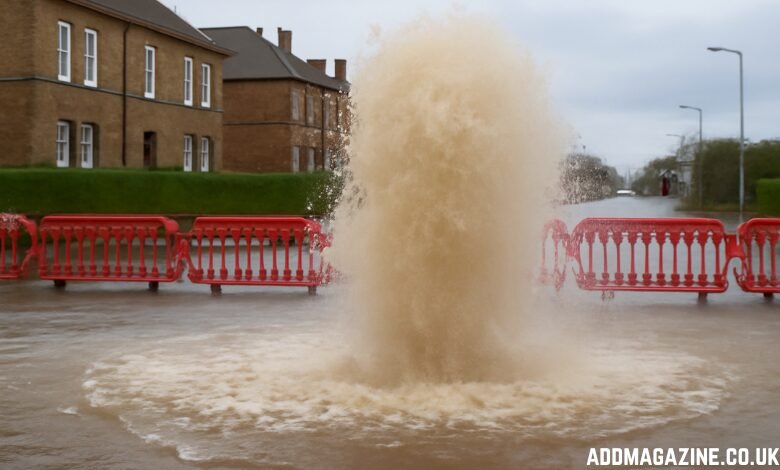A recent water main break on Shettleston Road in Glasgow’s East End has underscored the challenges faced by aging infrastructure in urban settings. The incident disrupted daily life for residents, commuters, and businesses, creating a ripple effect that emphasized the need for timely maintenance, swift emergency response, and preventive measures to avoid similar incidents in the future.
The Incident: A Major Disruption
The water main break occurred in one of Glasgow’s busiest streets, Shettleston Road, which serves as a vital route for both local traffic and commuters. As water poured onto the roadway, several sections of the road were immediately flooded, causing major disruptions. The rupture occurred in a major water pipeline running beneath the road, leading to an unexpected loss of water pressure and severe flooding that affected both vehicles and pedestrians.
The break led to widespread water outages across the G32 postcode area. For residents, this meant taps running dry or a significant reduction in water pressure. In some areas, water became discolored, either brown from stirred-up sediment or cloudy from trapped air. These inconveniences posed not only daily challenges but also raised concerns about hygiene and sanitation, particularly for families with young children and elderly residents.
Immediate Impact on Residents
For the residents of Shettleston Road and its neighboring areas, the water main break was more than just an inconvenience. Water supply interruptions, especially those that last for several hours, can severely affect a household’s ability to maintain basic daily functions, from cooking to cleaning to personal hygiene.
In this case, many households were left without water or faced low pressure, which complicated their day-to-day routines. Some residents reported discolored water, a common issue after a pipe break, due to the sediment or air that gets trapped within the system. For most people, these temporary disruptions are a reminder of how crucial the water supply is to modern life.
While the situation was undoubtedly frustrating for residents, vulnerable groups were disproportionately affected. The elderly, people with disabilities, and those with young children were among the hardest hit, as their need for a continuous water supply is often more immediate. These groups may also struggle to find alternative solutions when faced with such interruptions, particularly in the case of prolonged outages.
The Traffic Nightmare
Shettleston Road, a major traffic corridor in the East End of Glasgow, was significantly impacted by the water main break. The incident forced road closures from Old Shettleston Road to Fernan Street, a crucial stretch for commuters traveling into the heart of Glasgow. With Shettleston Road blocked, traffic was diverted onto nearby streets, including Westmuir Street, leading to long delays and severe congestion.
Commuters faced extended journey times, with reports of peak travel times doubling as drivers scrambled to find alternative routes. Public transportation services were also affected, with buses rerouted and schedules thrown off. This left passengers stranded or experiencing long wait times for alternative services.
For businesses located along Shettleston Road, the disruption had a direct impact on customer flow. With limited access to stores and shops, many establishments saw fewer customers and lower sales during the period of closure. This highlights the ripple effect that infrastructure issues can have on local economies, affecting both small businesses and larger commercial operations.
Causes and Contributing Factors
Water main breaks are not an uncommon occurrence in large cities, but they can become more frequent in older, historic urban areas. In cities like Glasgow, many of the water supply pipes date back several decades. Over time, these pipes can suffer from wear and tear, including corrosion, cracking, and general degradation. As a result, the risk of failure increases, especially when pipes are subjected to external pressure, ground movement, or extreme weather conditions.
Another contributing factor to the break in Shettleston Road was the sheer size and scale of the affected pipeline. Major water mains serve hundreds, if not thousands, of households and businesses. When one of these large pipes ruptures, the impact is far-reaching and often results in widespread outages and flooding, as seen in this instance.
While aging infrastructure is often the main culprit, other factors such as poor installation, operational issues, or external damage (such as construction activities or nearby excavation work) can also play a role. However, the primary cause in this case appears to be the inevitable deterioration of the city’s older water infrastructure.
Emergency Response and Restoration Efforts
Upon receiving reports of the water main break, Scottish Water immediately mobilized its teams to assess and resolve the situation. Crews worked quickly to isolate the damaged section of the pipeline, preventing further loss of water and mitigating the flooding that had affected the road. Meanwhile, efforts were made to reroute water supply through nearby valves and minimize the impact on residents and businesses.
Engineers worked tirelessly to repair the rupture, carefully removing the damaged pipe sections and replacing them with new, more reliable materials. The process was complex, as it required careful planning to minimize disruptions while ensuring public safety. Scottish Water teams communicated regularly with residents, providing updates on repair progress and estimated times for water restoration.
By isolating the affected section and rerouting supply, the utility was able to restore water to some households relatively quickly. However, areas directly affected by the rupture had to wait for full restoration, which took several hours for some.
The Role of Preventive Maintenance
The Shettleston Road water main break highlights the need for a more proactive approach to infrastructure maintenance. While emergency response teams did their best to minimize disruption, the incident underscores the importance of regular inspection, repair, and replacement of aging water pipes before they fail.
Preventive maintenance is critical in a city like Glasgow, where much of the water infrastructure is decades old. Regular monitoring, coupled with early detection systems that can identify wear and tear, is essential to minimizing the occurrence of such incidents. Investment in infrastructure upgrades is also necessary to keep pace with growing demand and the challenges posed by climate change.
Long-Term Solutions and the Need for Investment
Looking ahead, the Shettleston Road incident has called attention to the pressing need for investment in the city’s water infrastructure. Glasgow’s aging water supply system requires significant attention and funding to ensure it can meet the needs of its growing population. Upgrading pipes, especially those in high-risk areas, should be a priority for local authorities.
Scottish Water, as part of its long-term plan, will likely continue to prioritize investments in infrastructure renewal and preventative measures. In the meantime, city officials and infrastructure agencies need to collaborate to implement strategies that address the specific challenges of older cities.
Conclusion
The water main break on Shettleston Road was a reminder of the fragility of urban infrastructure and the importance of maintaining essential services for residents and businesses. While the swift response of Scottish Water teams was commendable, the incident highlighted how vulnerable urban areas are to the consequences of aging infrastructure.
The need for continued investment in infrastructure is clear. Only by addressing these issues head-on can cities like Glasgow prevent future disruptions and ensure that residents and businesses can rely on consistent, uninterrupted water supply in the years to come. This incident serves as a wake-up call for policymakers and utility providers to prioritize the modernization and maintenance of critical infrastructure to safeguard the city’s long-term resilience.
FAQs
- What caused the water main break on Shettleston Road in Glasgow?
- The break was primarily due to the aging infrastructure of the city’s water supply system, leading to pipe deterioration.
- How did the Shettleston Road water main break affect local residents?
- Many residents experienced water outages, low pressure, or discolored water, disrupting daily activities like cooking and cleaning.
- What steps were taken to repair the water main on Shettleston Road?
- Scottish Water crews quickly isolated the affected section, rerouted water supply, and worked on repairing the damaged pipeline.
- How did the water main rupture impact traffic on Shettleston Road?
- The break caused road closures and diversions, leading to significant traffic congestion and delays for commuters.
- How long did it take for the water supply to be restored after the break?
- It took several hours to restore water to most households, with some areas facing extended outages due to the severity of the damage.




